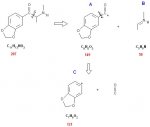Coolio
Greenlighter
- Joined
- Feb 29, 2004
- Messages
- 6,946
J Chromatogr Sci. 2006 Mar;44(3):155-61.
Chromatographic and mass spectral studies on methoxymethcathinones related to 3,4-methylenedioxymethamphetamine.
Awad T, Clark CR, DeRuiter J.
Department of Pharmacal Sciences, School of Pharmacy, Auburn University, Auburn, AL 36849, USA.
The methoxymethcathinones are uniquely regioisomeric with the controlled drug substance 3,4-methylenedioxymethamphetamine (3,4-MDMA) or Ecstacy. The various isomeric forms of the methoxymethcathinones have mass spectra essentially equivalent to 3,4-MDMA. They all have a molecular weight of 193 and major fragment ions in their electron ionization mass spectra at m/z 58 and 135/136. Differentiation by mass spectrometry was only possible after formation of the perfluoroacyl derivatives, pentafluoropropionylamides (PFPA), and heptafluorobutrylamides (HFBA). Gas chromatographic separation on nonpolar stationary phases successfully resolved the three methcathinones from 2,3- and 3,4-MDMA as the PFPA and HFBA derivatives.
Looks like methylone shows up as MDMA on mass spectrometry test results... and I can't determine from this abstract, but also GC is the same? Does this mean ecstasydata.org etc. results as well as submissions to DEA laboratories that show MDMA in pills might actually be methylone?




